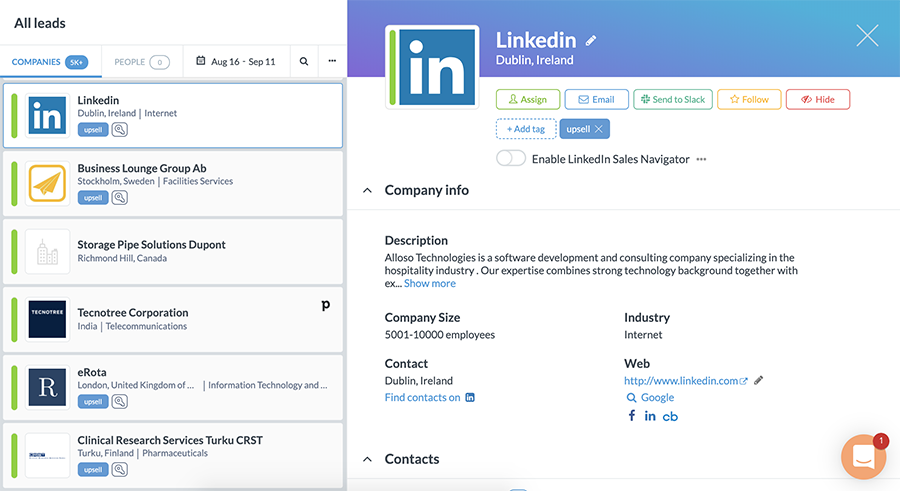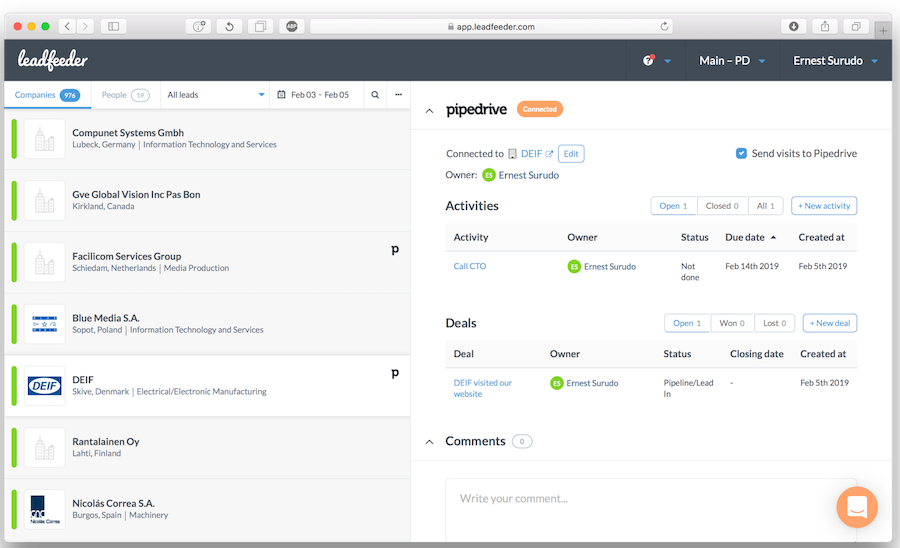For marketers trying to better understand which key performance indicators (KPIs) matter for their business, there’s plenty of content offering generic marketing KPIs as one-size-fits-all solutions.
But here’s the thing: There aren’t many marketing KPIs that truly matter for each and every business out there. And many of the articles you’ll find in search results present a decidedly B2C-centric view of marketing KPIs.
That doesn’t help B2B marketers. Instead, you need marketing reports that illuminate B2B performance, including for enterprise and account based marketing (ABM)—not those designed for B2C companies and small deals. B2B marketers need details like:
How each marketing campaign drives revenue
Account-level lead data
Multi-tiered lead quality info for longer deal cycles
To that end, in this article, we dive into:
Why B2B and ABM marketing teams need different KPIs than B2C
The 3 KPIs that actually matter for B2B
How we, at Leadfeeder, measure our B2B marketing KPIs
Note: Looking for more context on the KPIs you track? Sign up and try Leadfeeder free for 14 days to see the companies that visit your website, plus additional details like which pages they visit and how long they spend there.
Why B2B Marketing and ABM Need Different KPIs than B2C
When you’re focused on only a handful of potential customers, metrics like overall website traffic, bounce rate, and total email subscribers doesn’t tell the story of your B2B marketing efforts.
After all, the myriad differences between B2B and B2C companies all boils down to one main thing: the number and size of the customers you serve. B2B companies and those using account based marketing (ABM) typically focus on a smaller number of customers who each make up a larger amount of that company’s business.
The KPIs that work for B2C marketers:
Prioritize lead and traffic quantity over quality
Focus on leads as individuals, not accounts or decision-making teams
Measure fewer, less flexible conversion points along a shorter buying cycle
B2B companies, on the other hand, don’t need to care about sheer numbers or individual visitors—you need to know about the companies your marketing reaches and how it moves them toward conversion.
And that isn’t what traditional B2C metrics are designed to do. Because of that, we recommend B2B marketers focus their KPIs on three important metrics instead:
Marketing qualified leads (MQLs)
Lead quality
Revenue contributed
Let’s take a look at each.
B2B Marketing KPI #1: Marketing Qualified Leads (MQLs)
The vast majority of B2B marketers know they should be measuring lead generation as a KPI, and that often means tracking marketing qualified leads (or MQLs). That said, MQLs can go under-measured because they’re often poorly defined.
An MQL can be measured in a lot of different ways from sales pipeline to leads-to-sales to email subscriptions and more. The criteria that define an MQL naturally vary by company and the specifics of your customer lifecycle, and that can create ambiguity and confusion. As the saying goes, that which is ambiguous doesn’t get measured (okay, maybe we just coined that one).
But MQLs are also one of the best indicators of B2B marketing success and quantity of leads produced by marketing. Measuring MQLs tells you:
Whether your marketing campaigns are sending the right companies to your website
How effectively your messaging is warming and nurturing those for sales
The rate at which your website encourages visitors to convert in some way
So to get around all that vagueness, we recommend that marketing and sales teams work together to define explicit and strict criteria for what counts as an MQL—with lead qualifications pulled directly from real data on your existing customers.
We share more nitty-gritty details on how to do that in our piece on How Marketers Should Define and Qualify Leads.
B2B Marketing KPI #2: Lead Quality
While tracking MQLs can give you a good sense of the number of leads that meet a certain threshold of qualification, B2B marketers also need to understand the average quality, more generally, of the leads and visitors their efforts bring in.
Because you don’t just need to turn visitors into leads—you also need to attract the right companies to the website in the first place and turn leads into customers.
You might be happy with the number of MQLs your marketing brings in, but how many of those leads make it all the way through the buyer’s journey and become customers? MQLs represent only a portion of website visitors, and only an even smaller portion of them become actual customers.
To squeeze more MQLs out of your website visitors and to ensure more MQLs ultimately become customers, you need to measure lead quality.
There are a lot of ways to measure the quality of your leads and website visitors, but we recommend tracking these 3 KPIs:
Visitor-to-lead conversion
Leads-to-opportunities ratio
Time-to-conversion
We talk more about measuring lead quality with Leadfeeder, breaking it down by marketing campaign, diagnosing quality issues, and more in this article.
B2B Marketing KPI #3: Revenue Contributed
MQLs and lead quality each represent steps along the path of moving companies from website visitors to leads to new customers. But at the end of the day, marketing (and any other team, for that matter) is judged based on the revenue they contribute to the bottom line. Basically every other metric ties back to that: How is your B2B marketing driving revenue for the business?
To measure revenue contribution KPIs, you’ll need to set a marketing attribution model (or multiple models) to track how landing pages, UTM campaigns, and other marketing efforts lead to revenue.
Previously, we’ve argued for using both first- and last-click attribution models together. When you track attribution in Google Analytics and use custom goals to define conversion, you can set a dollar value for each conversion.

For a detailed breakdown of setting up our recommended attribution models in Google Analytics, read our post on How One B2B Agency Measures Marketing Performance.
How Leadfeeder Measures Our B2B Marketing KPIs
Most marketers lean on tools like Google Analytics to measure and track KPIs—but for B2B purposes, using Google Analytics alone can leave a gaping disconnect between numbers and the actual companies they represent. In part, that’s because Google Analytics measures website visitors on the individual level. But B2B marketers need account-level data.
That’s where our website visitor identification tool comes in, helping you put a face (or, in this case, a logo) to the data.

Leadfeeder data can tell you, among other details:
If the right companies visited your website
If they fulfilled your pre-defined conversion goals
Where they stand in the sales cycle (via our integrations with popular CRM software)

You can connect with popular CRMs (like Pipedrive) to pull up-to-date info into the company details in Leadfeeder.
For our own B2B reporting needs, we combine both Google Analytics and our own Leadfeeder data—and we use custom reports in Tableau to bring it all together. Here’s a look at some of the KPI reports we focus on:
Total new signups by month and qualified MQL conversion rate
New revenue each month—broken down by what came from inbound, outbound, and self-service
Predicted monthly recurring revenue (MRR) and predicted customer lifetime value (LTV) for new signups
The KPIs That Matter for B2B Marketers
B2B marketing and ABM are fundamentally different from B2C—you’re dealing with bigger customers, bigger deal sizes, and account-level data. With the 3 B2B marketing KPIs we recommend, you’ll be better equipped to capture relevant performance metrics that help you expand and improve upon your marketing efforts.
Note: Looking for more context on the KPIs you track? Sign up and try Leadfeeder free for 14 days to see the companies that visit your website, plus additional details like which pages they visit and how long they spend there.
Get more from your web analytics.
t’s time to turn your website traffic data into something more meaningful. Website visitor analytics enable you to identify and qualify the companies visiting your website, even when they don’t fill out a form.
Show me how




